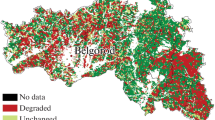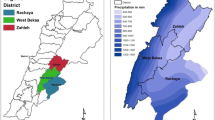Abstract
Early assessments of land degradation like the Global Assessment of Soil Degradation (GLASOD) (Oldeman et al. 1990) were compilations of expert opinion. They are unrepeatable and systematic data show them to be unreliable (Sonneveld and Dent 2009). Under the FAO/UNEP program Land Degradation in Drylands (LADA), Bai et al. (2008) undertook a global assessment of land degradation and improvement (GLADA) by analysis of linear trends of climate-adjusted GIMMS NDVI data. GLADA, the first quantitative assessment of global land degradation, aimed to identify and delineate hot spots of land degradation, and their counterpoint—bright spots of land improvement (Bai et al. 2008). The study revealed that about 24 % of the global land area was affected by land degradation between 1981 and 2003. Humid areas accounted for 78 % of the global degraded land area, while arid and semiarid areas accounted for only 13 %. Cropland and rangelands accounted for 18 % and 43 %, respectively, of the 16 % of global land area where the NDVI increased. The authors observed a positive correlation between population density and NDVI but, also, a correlation between poverty and land degradation. They emphasized that NDVI cannot be other than a proxy for land degradation and that it reveals nothing about the kind of degradation or the drivers (Bai et al. 2008).
Access this chapter
Tax calculation will be finalised at checkout
Purchases are for personal use only
Similar content being viewed by others
References
Bai ZG, Dent DL, Olsson L, Schaepman ME (2008) Proxy global assessment of land degradation. Soil Use Manag 24(3):223–234
Bartholomé E, Belward A (2005) GLC2000: a new approach to global land cover mapping from Earth observation data. Int J Remote Sens 26(9):1959–1977
Beck P, Karlsen S, Skidmore A, Nielsen L, Høgda K (2005) The onset of the growing season in northwestern Europe, mapped using MODIS NDVI and calibrated using phenological ground observations. In: 31st International Symposium on remote Sensing on Environment–Global Monitoring for Sustainability and Security, pp 20–24
CEISIN (2004) Global Rural–urban mapping project: urban/rural extents. Center for International Earth Science Information Network, Columbia University, Palisades
CEISIN (2007) Socioeconomic data applications center. Center for International Earth Science Information Network, Columbia University, Palisades
de Jong R (2010) Trends in soil degradation publications. IUSS Bulletin 116:21–25
FAO (2013) Land use systems of the world. Land cover and land use. Food and Agriculture Organization of the United Nations (FAO), Rome. http://www.fao.org/climatechange/54270/en/. Accessed 15 June 2013
ISRIC (2008a) Enhanced soil information for LADA partner countries, scale 1:1 million. World Soil Information (ISRIC), Wageningen
ISRIC (2008b) Global SOTER landform classification scale 1:1 million. World Soil Information (ISRIC), Wageningen
Jones P, Harris I (2013) CRU TS3.21: Climatic Research Unit (CRU) Time-Series (TS) Version 3.21 of high resolution gridded data of month-by-month variation in climate (Jan 1901–Dec 2012). University of East Anglia Climatic Research Unit (CRU), NCAS British Atmospheric Data Centre. http://badc.nerc.ac.uk/view/badc.nerc.ac.uk
Mitchell TD, Jones PD (2005) An improved method of constructing a database of monthly climate observations and associated high‐resolution grids. Int J Climatol 25(6):693–712
Morton DC, Nagol J, Carabajal CC, Rosette J, Palace M, Cook BD, Vermote EF, Harding DJ, North PR (2014) Amazon forests maintain consistent canopy structure and greenness during the dry season. Nature 506(7487):221–224
Oldeman L, Hakkeling R, Sombroek W (1990) World map on status of human-induced soil degradation (GLASOD) UNEP. ISRIC, Nairobi
Pinzon J, Tucker C (2014) A non-stationary 1981–2012 AVHRR NDVI3G time series. Remote Sens 6(8):6929–6960
Running SW, Nemani RR, Heinsch FA, Zhao M, Reeves M, Hashimoto H (2004) A continuous satellite-derived measure of global terrestrial primary production. Bioscience 54(6):547–560
Sonneveld B, Dent D (2009) How good is GLASOD? J Environ Manage 90(1):274–283
Author information
Authors and Affiliations
Rights and permissions
Copyright information
© 2015 The Author(s)
About this chapter
Cite this chapter
Yengoh, G.T., Dent, D., Olsson, L., Tengberg, A.E., Tucker, C.J. (2015). Development of Land Degradation Assessments. In: Use of the Normalized Difference Vegetation Index (NDVI) to Assess Land Degradation at Multiple Scales. SpringerBriefs in Environmental Science. Springer, Cham. https://doi.org/10.1007/978-3-319-24112-8_6
Download citation
DOI: https://doi.org/10.1007/978-3-319-24112-8_6
Published:
Publisher Name: Springer, Cham
Print ISBN: 978-3-319-24110-4
Online ISBN: 978-3-319-24112-8
eBook Packages: Earth and Environmental ScienceEarth and Environmental Science (R0)




